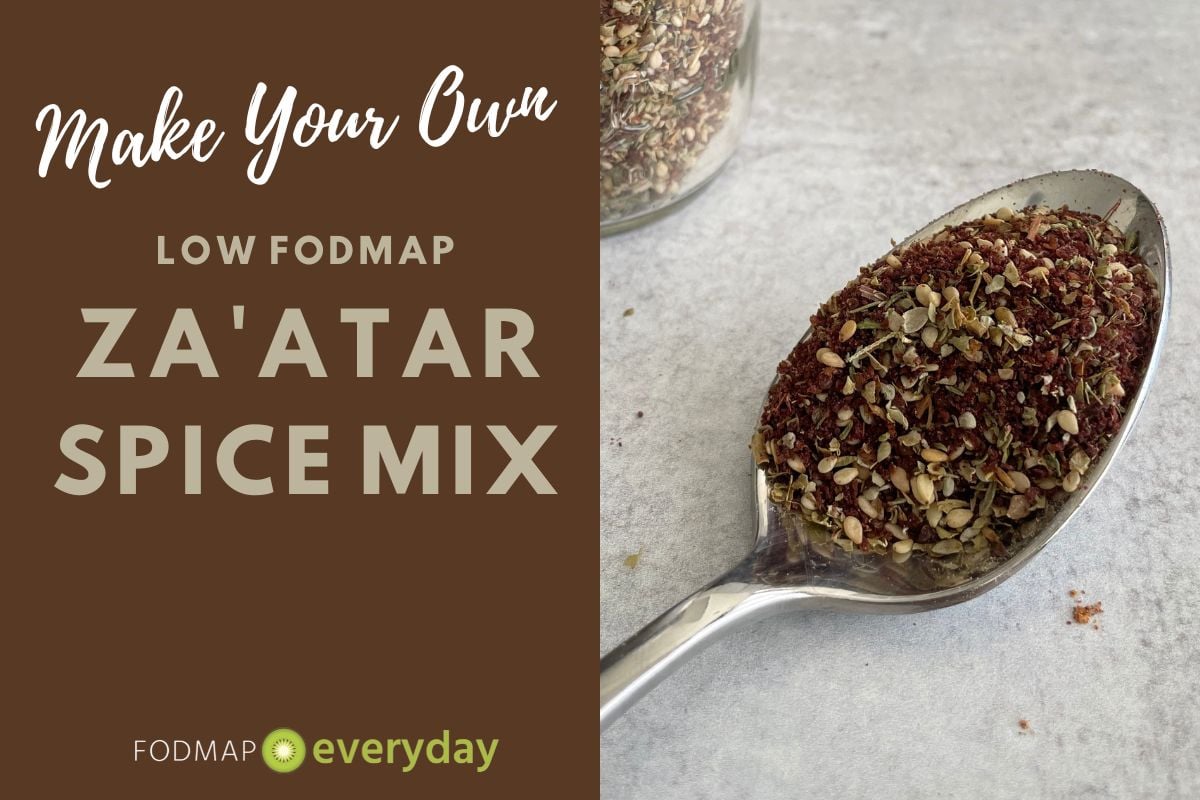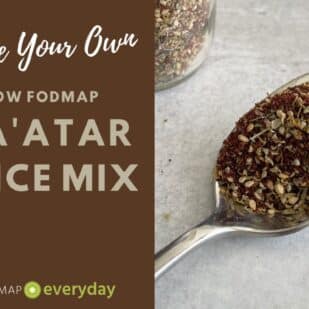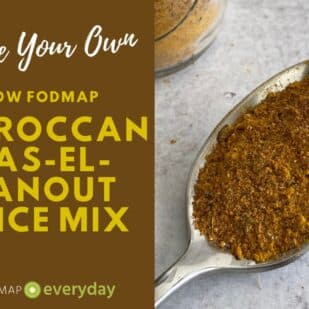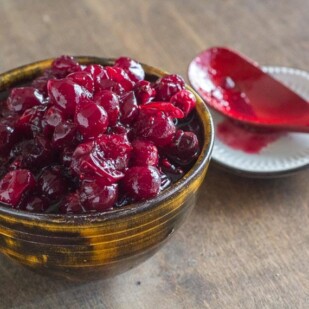Our Low FODMAP Mediterranean Za’atar Spice Mix combines tangy sumac, savory herbs and sesame seeds, just like the classic blends. For Middle Eastern cooking, za’atar is an absolute essential. Like Everything Bagel seasoning, za’atar is another wonderfully versatile blend that can serve many culinary functions.
What Do You Use Mediterranean Za’atar Spice Mix For?
It pairs naturally well with white fish and poultry, but it also serves as a perfect herbaceous spice base for a Mediterranean style salad dressing, a topping for avocado toast, or simply sprinkled over eggs, salads, and lunch bowls.
In terms of flavor, it adds a punch of dried herbs, toasted sesame seeds, and citrus-like notes from the sumac, which has been lab tested by Monash University (more below).

Untested Ingredients in the Mediterranean Za’atar Spice Mix
Marjoram, a key herb needed to add a tea-like medicinal note to the za’atar, has not been formally tested by the Monash University FODMAP team. However, like our logic in using celery seed for other recipes, dried marjoram contains only 1g carbohydrate and 0.8g fiber per tablespoon, making it unlikely to trigger IBS symptoms in the quantities used for this recipe.
Please read our article, Ask The Right Question: Is It Low FODMAP or Can I Tolerate This?
Frequently Asked Questions
This spice has a tangy, lemony flavor and adds a bright flavor to dishes. It is popular in Middle Eastern cooking and has been lab tested by Monash University. It is low FODMAP in 1 teaspoon (2 g) portions. It is a berry, that is dried, and the spice is typically sold in ground form.
Maldon salt flakes are a natural salt from England with a unique pyramidal shape that provides a sublime crunch. Recognized as some of the finest of sea salts in the world, they have a very fresh, clean flavor. Its texture is fabulous in this blend. You could also use kosher salt such as Morton’s(a tad smaller in size than Maldon) or Diamond Crystal (finer still). We suggest this order of choice as the bolder the texture the better for this recipe.
Low FODMAP Seasoning Blend Basics
Please refer to our article, How To Make Low FODMAP Seasoning Blends, for info on purchasing spices, toasting, storage and discussions on whole spices vs. pre-ground, the best tools for grinding your own, measuring, etc.
Please read it before beginning this recipe. You need to toast the sesame seeds and cool them before starting and there are directions in that article. We do not recommend buying them already toasted. You will lose out on flavor.
FODMAP Information
All recipes are based upon Monash University & FODMAP Friendly science at time of initial
- Herbs: Many fresh and dried herbs have been lab tested by both Monash University and FODMAP Friendly and are easily looked up in the apps, which we strongly suggest that you have. The additional good news is that if you are interested in an herb that has not been lab tested, you can look at the nutritional panel and assess its FODMAP load for yourself. If the “Sugars” and/or “Carbs” are 1 g or less per serving, then the item would be a good bet to try.
- Sesame Seeds: Monash University has lab tested white sesame seeds and they are low FODMAP in 1 tablespoon (11 g) portions.
- Spices: Many fresh and dried spice have been lab tested by both Monash University and FODMAP Friendly and are easily looked up in the apps, which we strongly suggest that you have. The additional good news is that if you are interested in a spice that has not been lab tested, you can look at the nutritional panel and assess its FODMAP load for yourself. If the “Sugars” and/or “Carbs” are 1 g or less per serving, then the item would be a good bet to try.
- Sumac: Monash University has lab tested sumac, which is a spice popular in Middle Eastern cooking. It is a dried berry that is typically sold in ground form and has a bright, acidic flavor, often described as “lemony”. It is low FODMAP in 1 teaspoon (2 g) portions.
Please always refer to the Monash University & FODMAP Friendly smartphone apps for the most up-to-date lab tested information. Foods will be retested from time to time; in the case of raw ingredients, such as fruits and vegetables, results may vary. All lab tested results are valid and represent a snapshot in time. As always, your tolerance is what counts; please eat accordingly. The ultimate goal of the low FODMAP diet is to eat as broadly as possible, without triggering symptoms, for the healthiest microbiome.
Flavor For Your FODMAP Cooking
Check out all of our other low FODMAP seasonings, all very easy to make.
- Low FODMAP Everything Bagel Seasoning
- Low FODMAP Cajun Spice Blend
- Low FODMAP Italian Seasoning
- Low FODMAP Taco Seasoning
- Low FODMAP Ethiopian Berbere Spice
- Low FODMAP Sweet BBQ Dry Rub
- Low FODMAP Smoky BBQ Dry Rub
- Low FODMAP Jamaican Jerk Seasoning
- Low FODMAP Tex Mex Seasoning
- Low FODMAP Moroccan Ras-el-Hanout Spice
- Low FODMAP Salt-Free Herb Mix
- Low FODMAP Dry Ranch Seasoning
- Low FODMAP Steak Seasoning
- Low FODMAP Garam Masala
- Low FODMAP Lemon Pepper Seasoning
- Low FODMAP Cumin Allspice Dry Rub
- Low FODMAP Sweet & Spicy Dry Rub

Low FODMAP Mediterranean Za’atar Spice
Our Low FODMAP Mediterranean Za’atar Spice combines tangy sumac, savory herbs and sesame seeds, just like the classic blends. For Middle Eastern cooking, za’atar is an absolute essential. Like Everything Bagel seasoning, za’atar is another wonderfully versatile blend that can serve many culinary functions.
Low FODMAP Serving Size Info: 1 ⅛ cups (108 g); 18 servings; 1 tablespoon per serving
Ingredients:
- 1/2 cup (58 g) ground sumac
- 3 tablespoons dried marjoram
- 3 tablespoons dried thyme
- 2 tablespoons toasted white sesame seeds
- 1 1/2 tablespoons dried oregano
- 2 teaspoons Maldon Sea salt flakes
- 1/2 teaspoon freshly ground black pepper
Preparation:
-
In a small mixing bowl, stir together all of the ingredients until well combined.
-
Store in an airtight container in a cool, dark location. Use within 6 months, for best flavor.
Notes:
FODMAP Information
All recipes are based upon Monash University & FODMAP Friendly science at time of initial
• Herbs: Many fresh and dried herbs have been lab tested by both Monash University and FODMAP Friendly and are easily looked up in the apps, which we strongly suggest that you have. The additional good news is that if you are interested in an herb that has not been lab tested, you can look at the nutritional panel and assess its FODMAP load for yourself. If the “Sugars” and/or “Carbs” are 1 g or less per serving, then the item would be a good bet to try.
• Sesame Seeds: Monash University has lab tested white sesame seeds and they are low FODMAP in 1 tablespoon (11 g) portions.
• Spices: Many fresh and dried spice have been lab tested by both Monash University and FODMAP Friendly and are easily looked up in the apps, which we strongly suggest that you have. The additional good news is that if you are interested in a spice that has not been lab tested, you can look at the nutritional panel and assess its FODMAP load for yourself. If the “Sugars” and/or “Carbs” are 1 g or less per serving, then the item would be a good bet to try.
• Sumac: Monash University has lab tested sumac, which is a spice popular in Middle Eastern cooking. It is a dried berry that is typically sold in ground form and has a bright, acidic flavor, often described as “lemony”. It is low FODMAP in 1 teaspoon (2 g) portions.
Please always refer to the Monash University & FODMAP Friendly smartphone apps for the most up-to-date lab tested information. Foods will be retested from time to time; in the case of raw ingredients, such as fruits and vegetables, results may vary. All lab tested results are valid and represent a snapshot in time. As always, your tolerance is what counts; please eat accordingly. The ultimate goal of the low FODMAP diet is to eat as broadly as possible, without triggering symptoms, for the healthiest microbiome.
Nutrition
All nutritional information is based on third-party calculations and should be considered estimates. Actual nutritional content will vary with brands used, measuring methods, portion sizes and more. For a more detailed explanation, please read our article Understanding The Nutrition Panel Within Our Recipes.







